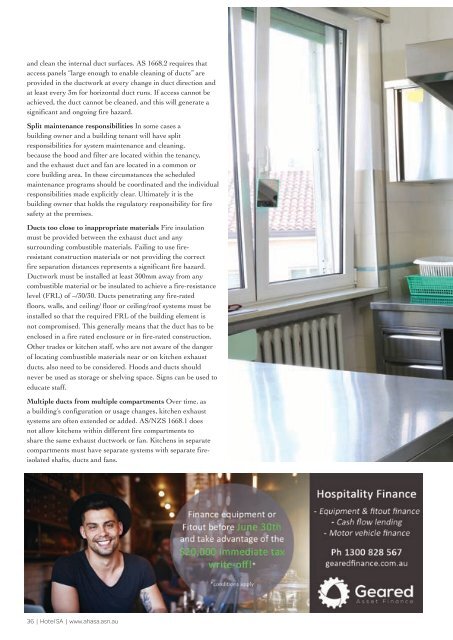HSA Feb_Mar 18_Web
You also want an ePaper? Increase the reach of your titles
YUMPU automatically turns print PDFs into web optimized ePapers that Google loves.
and clean the internal duct surfaces. AS 1668.2 requires that<br />
access panels “large enough to enable cleaning of ducts” are<br />
provided in the ductwork at every change in duct direction and<br />
at least every 3m for horizontal duct runs. If access cannot be<br />
achieved, the duct cannot be cleaned, and this will generate a<br />
significant and ongoing fire hazard.<br />
Split maintenance responsibilities In some cases a<br />
building owner and a building tenant will have split<br />
responsibilities for system maintenance and cleaning,<br />
because the hood and filter are located within the tenancy,<br />
and the exhaust duct and fan are located in a common or<br />
core building area. In these circumstances the scheduled<br />
maintenance programs should be coordinated and the individual<br />
responsibilities made explicitly clear. Ultimately it is the<br />
building owner that holds the regulatory responsibility for fire<br />
safety at the premises.<br />
Ducts too close to inappropriate materials Fire insulation<br />
must be provided between the exhaust duct and any<br />
surrounding combustible materials. Failing to use fireresistant<br />
construction materials or not providing the correct<br />
fire separation distances represents a significant fire hazard.<br />
Ductwork must be installed at least 300mm away from any<br />
combustible material or be insulated to achieve a fire-resistance<br />
level (FRL) of –/30/30. Ducts penetrating any fire-rated<br />
floors, walls, and ceiling/ floor or ceiling/roof systems must be<br />
installed so that the required FRL of the building element is<br />
not compromised. This generally means that the duct has to be<br />
enclosed in a fire rated enclosure or in fire-rated construction.<br />
Other trades or kitchen staff, who are not aware of the danger<br />
of locating combustible materials near or on kitchen exhaust<br />
ducts, also need to be considered. Hoods and ducts should<br />
never be used as storage or shelving space. Signs can be used to<br />
educate staff.<br />
Multiple ducts from multiple compartments Over time, as<br />
a building’s configuration or usage changes, kitchen exhaust<br />
systems are often extended or added. AS/NZS 1668.1 does<br />
not allow kitchens within different fire compartments to<br />
share the same exhaust ductwork or fan. Kitchens in separate<br />
compartments must have separate systems with separate fireisolated<br />
shafts, ducts and fans.<br />
36 | Hotel SA | www.ahasa.asn.au


















